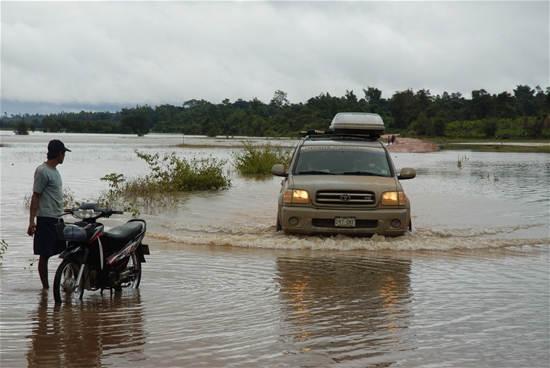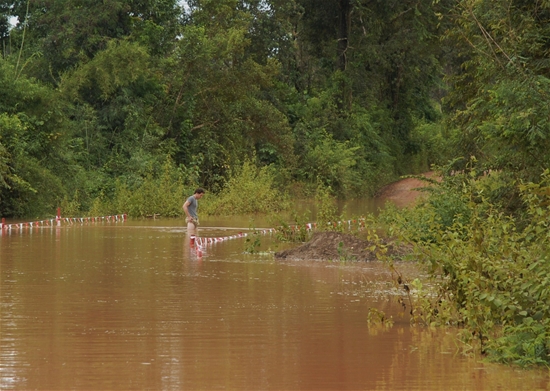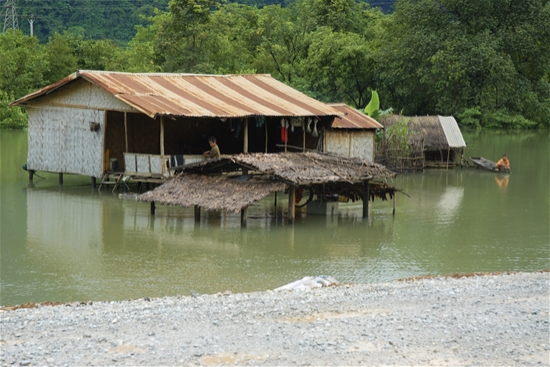In the early planning phases for the World by Road, we wanted to be as flexible as possible in determining our route and setting timeframes for each country. There were, however, a few macro-level timeframes that we wanted to maintain to make overland travel in certain regions of the world as easy as possible. Namely, we wanted to avoid monsoon season in SE Asia, winter in Siberia and summer in the Sahara. For the most part, we will avoid being in the thick of bad weather in these regions, but by pushing our departure date back a few months from December 2006 to February 2007, we knew we would hit at least some of the monsoon rains here in Asia.
Throughout Malaysia, Thailand and most of Cambodia, we dabbled in the very beginning of the rainy season. It did rain more than we were used to at home and when it did rain, it was a lot heavier than any of us had ever seen, but the rains came at pretty predictable times in the day and only lasted for a few hours. Although we are now in the thick of the rainy season here in SE Asia, we were beginning to think that somehow our route and timing would allow us to avoid the bad stuff due to regional variations in the weather patterns.
Unfortunately, most of our luck in terms of wet weather seems to have run out for the time being. After heading into northeastern Cambodia and further north into Laos and the relatively higher elevations, the heavens opened up and they have yet to let up. It has been raining hard and steady most of the day and into the night pretty much for the last 2 weeks and according to the locals, it will be like this until October and get worse.
Although I enjoy a good rain shower and find it soothing to the soul from time to time, consistent and steady rain really dampens your spirit after a while (pun intended). Many of the daytime activities you could enjoy are limited due to the weather as the ground becomes muddy, most of your belongings begin to take on the color of the iron-rich red soil, and driving down a major highway becomes a risky adventure.
Just the other day, we headed out to see some amazing caves in Central Laos. The thought was that we could at least seek temporary refuge from the rains while exploring the cave system on our way north. We left town bright and early and headed down what our map indicated was a major national thoroughfare. After about 50 kilometers, we soon realized that this map was mistaken about the size and quality of the highway as the road surface by that point consisted of about 3-4 inches of mud. About 40 kilometers more in 4-wheel drive mode, the rain finally stopped for about 15 minutes only to leave us staring at what looked like the end of the line. As soon as we were about to pull up our pants and see if we could find our way to the other side of what appeared to be a large lake, a local guy on a moto came to the rescue and we followed him in the Toyotas with white knuckle grips on the steering wheels.


We reached it safely across the water only to come across another river 5 kilometers down the road. This time, no motos, so I hiked up my shorts and joined the bathing water buffalo to try and gauge the depth of the water hazard in front of us. It seemed o.k., but a local coming the other way informed us through sign language (he pointed above his waist) that a river crossing farther down the road was too deep. Oh, well, no caves today and nearly 7 hours of driving to go about 100 miles, only to end up back where we started but hey, it is the rainy season here and you kind of just have to accept it. On the bright side, we did get some great shots of the trucks and see some pretty interesting glimpses of rainy season Laotian village life. I just hope it lets up a little bit, because the wet weather is not conducive to getting much of anything done… you just find a hammock, crack a Beer Lao, do some reading/research and wait for dryer weather like the locals do. Besides, it could be far worse, right now just to the west in India and Bangladesh, severe monsoon flooding is killing hundreds of people and displacing millions.

